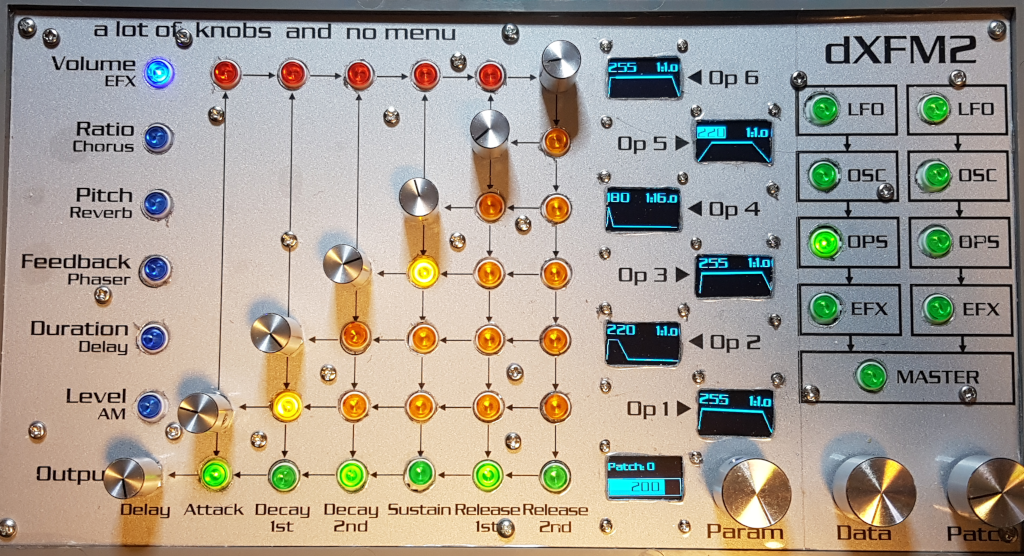A FM synthesizer with a lot of knobs and no menu!
Always wanted to create lush FM sounds? But to afraid of the menu-driven horrors of FM synthesizers, like the illustrious Yamaha DX7?
The dXFM2 aims to be just that: an FM synthesizer, with the physical feel of an analog synthesizer: a lot of knobs and no menu.
The dXFM2 is based on the incredible work of René Ceballos. He created the XFM2 synthesizer module, a 64-voice, 2-part, 6-operator FM synthesizer with built-in effects processor, built on an FPGA chip. You can find all the information at www.futur3soundz.com. The dXFM2 complements this with the physical controls for the FPGA chip, managed by a Teensy 4.0.
All build descriptions can be found here. Please note that this is a somewhat free-format description and not intended as build instructions: most things I just found out on-the-fly, so some descriptions might not be completely correct any more.
I always wanted to have an FM synth that I could "understand" just from looking at the display. I do understand the concepts of FM synthesis: carriers that are modulated by modulators. But in most FM synthesizers, it is not clear which operator is a carrier and which operator is a modulator, and to what extend. The dXFM2 overcomes this problem:
- Every dial corresponds to exactly one operator (the 1 knob for 1 function principle);
- A dedicated dial is used for the output of the synth;
- A green LED indicates that the operator in that column is a carrier (follow the arrows): the "green row" corresponds to the output of the synth;
- A yellow LED indicates that the operator in that column is a modulator for the operator in the corresponding row;
- A red LED indicates that the operator in that column is a modulator for operator 6, notably creating a feedback loop.
This LED-matrix makes the carrier-modulator algorithm visible in a what-you-see-is-what-you-get kind of way. And you can change this on the fly, just by pressing the LED (it's actually a push button).
Some other parameters are very important for the FM sound synthesis:
- The level of the operator;
- The amplitude envelope shape;
- The ratio between operators;
- Whether an operator is modulating itself (feedback).
An as you can see: every operator has its own dedicated small LED screen that displays just this information. The seventh LED screen depicts global information, or in this case: the output volume and the active patch.
Although the sound of the FM synthesizer is pretty much in your face, the manipulation of that sound does actually involve a bit of menus. For this, you use the green LED buttons on the right side of the synthesizer, selecting a specific page. This activates a particular set of options, which you can further select by using the blue LED buttons on the left side of the synthesizer.
When you look at the green LED buttons, you see that two rows of identical options are available. The dXFM2 has two identifical FM synth units, and by selected between the left or right column, you select the unit for which you want to change a parameter.
- LFO will enable the parameter page for the low frequency oscillator;
- OSC will enable the parameter page for the sound oscillators;
- OPS will enable the parameter page for the operators (selected by default);
- EFX will enable the parameter page for the effects;
- MASTER will enable the parameter page for some global parameters.
And if you really want to do some menu-diving, three additional dials are available:
- The Param dial gives you access to a regular menu. From this menu, you can change some more exotic parameters or have some extra options to ease the workflow while shaping FM sounds.
- With the Data dial you change some parameter value, as selected with the Param dial.
- With the Patch dial you activate a previously stored patch from the XFM2 memory banks (127 patches are available). Select a patch by turning the dial, and activate a patch by pushing the dial (all dials are actually push buttons as well as encoders).
